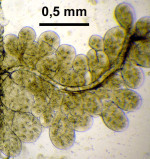Use of drone-breeding workers for breeding individually expressed traits of the honey bee
| Funding code: | |
| Acronym: | |
| Involved employees: | J. Wegener, Prof. Dr. K. Bienefeld |
| Co-operation partners: | Charité |
| Duration: | 2004 - 2007 |
| Financing: | F. Schaumann Stiftung |
The selection method favoured at LIB requires the keeping and reproduction of individual worker bees within a larger number of nurse bees, and the suppression of reproduction of nurse bees. In recent years, the suppression of the nurse bees' egg deposition has proven to be very difficult. Even very young nurse bees lay eggs and often suppress the reproduction of the selected worker bees because of their numerical superiority. As part of the project, the following possible influences are to be examined that serve the promotion of reproduction of individual worker bees and/or the suppression of reproduction of the nurse bees:
- number of nurse bees
- specific feeding
- hormone treatment
- keeping attendant bees without comb contact
- sterilisation by means of electromagnetic radiation
treatment with growth regulators
Publications:
- Wegener, J., Zautke, F., Höcht, S.; Köhler, B. Bienefeld, K.(2006) Suppression of worker fertility in the honeybee (Apis mellifera) by treatment with X-rays. Journal of Apicultural Research 45(1), 27-32
- Wegener, J. Bienefeld, K.(2006) Competition behaviour of laying worker honeybees Apidologie 37(5), 618 - 620
- Wegener, J.; Huang, Z.; Bienefeld, K.(2007) The role of ecdysteroid hormones in young worker honeybees. Apidologie 38(5), 490
- Wegener, J., Bienefeld, K. (2007) Influence of exogenous queen mandibular gland pheromones on social interactions within queenless groups of honeybee workers, Proc. 40th. Apimondia International Congress, Melbourne, p 145
- Wegener, J., Lorenz. M.L, Bienefeld, K. (2009) Physiological consequences of prolonged nursing in the honeybee. Insectes Sociaux 56, 85-93
- Wegener, J., Al Kahtani, S., Bienefeld, K.(2009) Collection of viable honey bee (Apis mellifera) larvae after hatching in vitro Journal of Apicultural Research 48(2), 115-120
- Wegener, J., Bienefeld, K. (2009) Methoden zur Zucht der Honigbiene unter Nutzung der Nachkommen von Arbeiterinnen. Züchtungskunde 81(4), 265-278
- Wegener, J., Huang, Z. Y.; Lorenz: M.L, Bienefeld, K. (2009). Regulation of hypopharyngeal gland activity and oogenesis in honey bee (Apis mellifera)workers. Journal of Insect Physiology 55, 716-725
- Wegener, J., Lorenz. M.L, Bienefeld, K. (2010) Differences between queen- and worker-laid eggs of the honey bee (Apis mellifera) Apidologie 41(1), 116-126
- Wegener, J., Lorenz, M.W., Bienefeld, K. (2011) Reproductive status and composition of spermathecal glands of honey bee queens Apidologie 42 (6) 787.
- Wegener, J., Huang, Z. Y.; Lorenz: M.L, Lorenz: J.I. Bienefeld, K. (2013) New insights into the roles of juvenile hormone and ecdysteroids in honey bee reproduction Journal of Insect Physiology 59(7), 655-661


